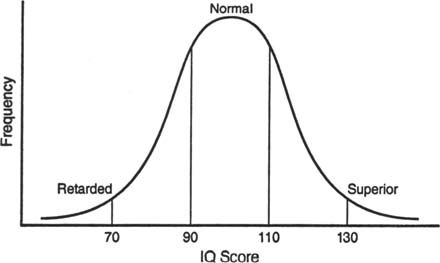INTELLIGENCE
- Sir Francis Galton, a pioneer in the measurement of individual differences in late nineteenth-century England, was particularly concerned with sensory responses (visual and auditory acuity and reaction times) and their relationship to differences in ability.
- Several individual tests have been used to test intelligence.
- The Binet-Simon intelligence scale, developed by French psychologists Alfred Binet and Theodore Simon, was administered to children to evaluate their performance ( mental age) at a givenchronological age. The mental age/chronological age measure, called amental quotient, was used to evaluate a child's learning potential.
- Lewis Terman of Stanford University revised the Binet scale in 1916. The revised scale, called the Stanford-Binet intelligence scale, although it retained the concept of mental and chronological ages, introduced the concept of the intelligence quotient (IQ) arrived at by the following widely used formula, which allows comparison between children of different ages.

J.P. Guilford
Structure of Intellect
Structure of Intellect is a general theory of human intelligence.
This is a three-dimensional model in which Guilford identified three fundamental components of intelligence. These were
1. Operations (five kinds)
2. Contents (five kinds)
3. Products (six kinds)
The model postulates that all three components are independent and combine freely, forming 150 components of intelligence. (5 x 5 x 6 = 150.)
Note that the notion that intellectual skill in one category is independent of skills in another category is shared by Howard Gardner in his theory of multiple intelligences.
Operation #1 = Evaluation
Contents = Visual
Products = Units
Operation #2
Convergent Production
Contents = Auditory
Products = Classes
Operation #3
Divergent Production
Contents = Symbolic
Products = Relations
Operation #4
Memory
Contents = Semantic
Products = Systems
Operation #5
Cognition
Cpmtemts = Behavioral
Products = Transformation
Guilford was interested in developing operational definitions through psychometric tests which he developed and used to measure the abilities predicted by the Structure of Intellect theory. He was interested in how creativity was generated and used his model to explore this area.
- Cognition - The ability to understand, comprehend, discover, and become aware.
- Memory - The ability to encode information and recall information. Later divided into
- Divergent Production - The process of generating multiple solutions to a problem
- Convergent Production - The process of deducing a single solution to a problem.
- Evaluation - The process of judging whether an answer is accurate, consistent, or valid.
- Figural - Information that is non-verbal or pictorial. Later divided into
- Symbolic - Information perceived as symbols or signs that have no meaning by themselves; for example, Arabic numerals or the letters of an alphabet.
- Semantic - Information perceived in words or sentences, whether oral, written, or silently in one's mind.
- Behavioral - Information perceived as acts of an individual or individuals.
- Unit - Represents a single item of information.
- Class - A set of items that share some attributes.
- Relation - Represents a connection between items or variables; may be linked as opposites or in associations, sequences, or analogies.
- System - An organization of items or networks with interacting parts.
- Transformation - Changes perspectives, conversions, or mutations to knowledge; such as reversing the order of letters in a word.
- Implication - Predictions, inferences, consequences, or anticipations of knowledge.
